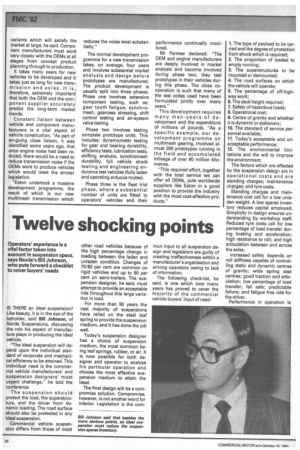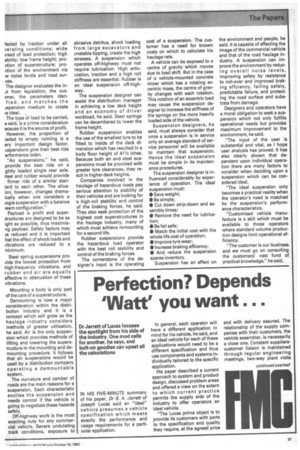Twelve shocking points
Page 34

Page 35

If you've noticed an error in this article please click here to report it so we can fix it.
Operators' experience is a vital factor taken into account in suspension specs, says Norde's Bill Johnson, who puts forward a checklist to cover buyers' needs
IS THERE an ideal suspension? Like beauty, it is in the eye of the beholder, said Bill Johnson, of Norde Suspensions, discussing the role his aspect of manufacture plays in producing the ideal vehicle.
"The ideal suspension will depend upon the individual standard of corporate and mechanical efficiency to be attained. This individual need is the commercial vehicle manufacturers' and suspension designers' most urgent challenge," he told the conference.
The suspension should protect the load, the superstructure, and the driver from dynamic loading. The road surface should also be protected in any ideal suspension.
Commercial vehicle suspension differs from those of most other road vehicles because of the high percentage change in loading between the laden and unladen condition. Changes of 70/80 per cent are common on rigid vehicles and up to 90 per cent on semi-trailers. The suspension designer, he said, must attempt to provide an acceptable ride throughout this large variation in load.
For more than 90 years the vast majority of suspensions have relied on the steel leaf spring to provide the suspension medium, and it has done the job well.
Today's suspension designer has a choice of suspension medium, the most common being leaf springs, rubber, or air. It is now possible for both designer and operator to analyse his particular operation and choose the most effective suspension medium to attain the ideal.
The final design will be a compromise solution. Compromise, however, is not another word for inferior. Legislation is the corn mon input to all suspension design and legislators are guilty of creating ineffectiveness within a manufacturer's organisation and among operators owing to lack of information.
The following check-list, he said, is one which over many years has proved to cover the majority of the commercial vehicle buyers' input of need: 1. The type of payload to be carried and the degree of protection from shock which is required; 2. The proportion of loaded to empty running; 3. The superstructures to be mounted or demounted; 4. The road surfaces on which the vehicle will operate; 5. The percentage of off-highway work; 6. The deck height required; 7. Safety of hazardous loads; 8. Operational cost; 9. Centre of gravity and whether it is dynamic or stationary; 10. The standard of service personnel available; 11. Today's acceptable and unacceptable performance; 12. The environmental limitations and the will to improve the environment.
The factors which are affected by the suspension design are in operational costs and are standing charges; maintenance charges; and tyre costs.
Standing charges and maintenance cost call for a low unladen weight. A low spares inventory reduces capital employed. Simplicity in design ensures understanding by workshop staff. Reduced tyre costs call for low percentage of load transfer during braking and acceleration; high resistance to roll; and high articulation between and across the axles.
Increased safety depends on roll stiffness capable of controlling static and dynamic centres of gravity; wide spring seat centres; good traction and articulation; low percentage of load transfer; fail safe; predictable failure; and fatigue free ride for the driver.
Performance in operation is fected by traction under all aerating conditions; wide bread of load protection; high ability; low frame height; proction of superstructure; proction of the environment via w noise levels and road surces.
The designer evaluates the init from legislation, the cusomen the parameters idenfied, and matches the Jspension medium to create le ideal.
The type of load to be carried, e said, is a prime consideration ecause it is the source of profit. However, the proportion of )aded to empty running is a ery important design factor. .uspensions give their best ride erformance laden.
"Air suspensions," he said, provide the best ride on a ghtly loaded single rear axle. ;Wel and rubber would provide firmer ride of a similar stenlard to each other. The situaion, however, changes dramaically when one considers a )ogie suspension with a balance )eam configuration."
Payload is profit and superdructures are designed to be as ight as possible, thus maximisng payload. Safety factors may ae reduced and it is important .hat the effect of shock loads and ribrations are reduced to a ninimum.
Steel spring suspensions provide the lowest protection from high-frequency vibrations, and rubber and air are equally effective in attenuation of these vibrations.
Mounting a body is only part of the care af a superstructure. Demounting is now a major consideration within the distribution industry and it is a concept which will grow as the haulage industry considers methods of greater utilisation, he said. Air is the only suspension which provides methods of lifting and lowering the superstructure in the mounting and demounting procedure. It follows that air suspensions would be used by a distribution company operating a demountable system.
The curvature and camber of roads are the main reasons for a suspension. Each characteristic excites the suspension and needs control if the vehicle is going to negotiate these hazards safely.
Off-highway work is the most exacting duty for any commercial vehicle. Severe undulating track conditions, exposure to abrasive detritus, shock loading from large excavators and unstable tipping, create the high stresses. A suspension which operates off-highway must not require lubrication. High articulation, traction and a high roll stiffness are essential. Rubber is an ideal suspension off-highway.
The suspension designer can assist the distribution manager in achieving a low deck height and an economy of driver workload, he said. Steel springs can be decambered to lower the frame height.
Rubber suspension enables the use of the smallest tyre to be fitted to inside of the deck dimension which has resulted in a body floor height of 411/2 iches. Because both air and steel suspensions must be provided with greater tyre clearances, they result in higher deck heights.
Companies involved in the haulage of hazardous loads pay serious attention to stability of their vehicles and are looking for 'a high-roll stability and control of the braking forces, he said. They also seek protection of the highest cost superstructures in the haulage industry, many of which must achieve remounting for a second life.
Rubber suspensions provide the hazardous load operator with the best roll stability and control of the braking forces.
The cornerstone of the designer's input is the operating cost of a suspension. The customer has a need for known costs on which to calculate his haulage rate.
A vehicle can be exposed to a centre of gravity which moves due to load shift. But in the case of a vehicle-mounted concrete mixer which has a rotating eccentric mass, the centre of gravity changes with each rotation. This rotation of an eccentric load may cause the suspension designer to increase the stiffness of the springs on the more heavily loaded side of the vehicle.
Suspension designers, he said, must always consider that once a suspension is in service only an average standard of service personnel will be available to maintain that suspension. Hence the ideal suspension must be simple in its maintenance procedures.
The suspension designer is influenced considerably by experience of operation. The ideal suspension must: • Save weight; • Be simple; • Cut down strip-down and assembly times; • Remove the need for lubrication; • Be fail safe; • Match the initial cost with the whole life cost of operation; • Improve tyre wear; • Increase braking efficency; • And reduce the suspension spares inventory. Suspension has an effect on the environment and people, he said. It is capable of affecting the image of the commercial vehicle and that of the road haulage industry. A suspension can improve the environment by reducing overall noise levels, improving safety by resistance to roll-over and improved braking effciency, failing safely, predictable failure, and protecting the road surface and substrata from damage.
Designers and operators have a moral obligation to seek a suspension which not only fulfills operational needs but provides maximum improvement to the environment, he said.
"The input of the user is substantial and vital, as I hope user analysis has proved. It has also clearly shown that dependent upon individual operation there are many factors to consider when deciding upon a suspension which can be considered ideal.
"The ideal suspension only becomes a practical reality when the operator's need is matched by the suspension's performance characteristics.
"Customised vehicle manufacture is a skill which must be available to those operators where standard volume production designs limit operational efficiency.
"The customer is our business and we must go on consulting the customers' vast fund of practical knowledge," he said.




















































































